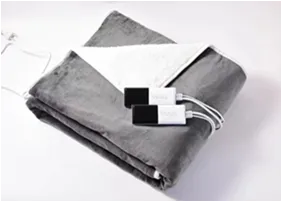Nov . 11, 2024 11:41 Back to list
electric blanket kwh
Understanding the Energy Consumption of Electric Blankets kWh and Beyond
As winter approaches, many seek comfort in electric blankets, which promise warmth during chilly nights. While these cozy companions provide soothing heat, it's essential to consider their energy consumption, particularly measured in kilowatt-hours (kWh). Understanding electrical usage not only helps in managing utility bills but also plays a crucial role in making environmentally conscious choices.
What is Kilowatt-Hour (kWh)?
Before diving into electric blankets, it's important to clarify what kWh means. A kilowatt-hour is a unit of energy equivalent to using one kilowatt (1,000 watts) of power for one hour. For instance, if a device consumes 100 watts, it would use 0.1 kWh over a period of 1 hour. This unit is commonly used by utility companies to measure electricity consumption and is crucial for consumers to evaluate their energy usage and costs.
How Much Energy Does an Electric Blanket Use?
The energy consumption of electric blankets can vary based on several factors including the blanket's settings, size, and the specific model. Typically, electric blankets can consume anywhere from 60 to 120 watts on high settings. For a more detailed breakdown, let’s examine two common use cases
1. Low Setting If an electric blanket operates at approximately 60 watts on a low setting and is used for 8 hours each night, the daily kWh consumption would be calculated as follows
\[ kWh = (60 \, \text{watts} \times 8 \, \text{hours}) / 1000 = 0.48 \, \text{kWh} \]
Over a month (30 nights), this totals approximately
\[ 0.48 \, \text{kWh} \times 30 = 14.4 \, \text{kWh} \]
If the cost of electricity is around $0.12 per kWh, the monthly expense would be
\[ 14.4 \, \text{kWh} \times 0.12 = \$1.73 \]
2. High Setting On the high setting (say, 120 watts) for the same duration, the calculations would change
electric blanket kwh

\[ kWh = (120 \, \text{watts} \times 8 \, \text{hours}) / 1000 = 0.96 \, \text{kWh} \]
The monthly usage would increase to
\[ 0.96 \, \text{kWh} \times 30 = 28.8 \, \text{kWh} \]
This translates to a cost of
\[ 28.8 \, \text{kWh} \times 0.12 = \$3.46 \]
Energy Efficiency Tips
To maximize comfort while minimizing energy consumption, consider the following tips
1. Use Automatic Shut-off Features Many electric blankets come with timers or automatic shut-off features that can help save energy. These features ensure the blanket isn’t left on longer than necessary.
2. Start Warm, Then Turn Down Preheat your blanket for about 30 minutes before getting into bed on a higher setting, and then reduce it to low for overnight comfort.
3. Layer Smartly Use your electric blanket in conjunction with regular blankets. Once warm, you might find you need less electricity to stay cozy.
4. Check for Energy-Efficient Models When purchasing an electric blanket, look for energy-efficient designs or certifications. Some models are designed to consume less power while providing adequate warmth.
Conclusion
Electric blankets are a practical solution for keeping warm during cold nights. While they do consume electricity measured in kWh, understanding their usage can help manage costs effectively. By making informed decisions about how and when to use your electric blanket, you can enjoy cozy nights while maintaining a reasonable electricity bill. With some thoughtful practices, you can indulge in warmth without the guilt of soaring energy costs or environmental impact. Embrace the cold months ahead!
-
Keep Your Furry Friends Warm with Our Pet Electric Blankets
Aug.07,2025
-
Keep Your Furry Friends Cozy with a Pet Heating Blanket
Aug.07,2025
-
Heated Mattress Blankets
Aug.07,2025
-
Experience Unmatched Comfort with Electric Blanket Double
Aug.07,2025
-
Warm Winter: The Perfect Choice For A Cozy Electric Blanket
Aug.07,2025
-
Discover the Comfort of Heating Pads for Relief and Relaxation
Aug.07,2025
Realted Products




